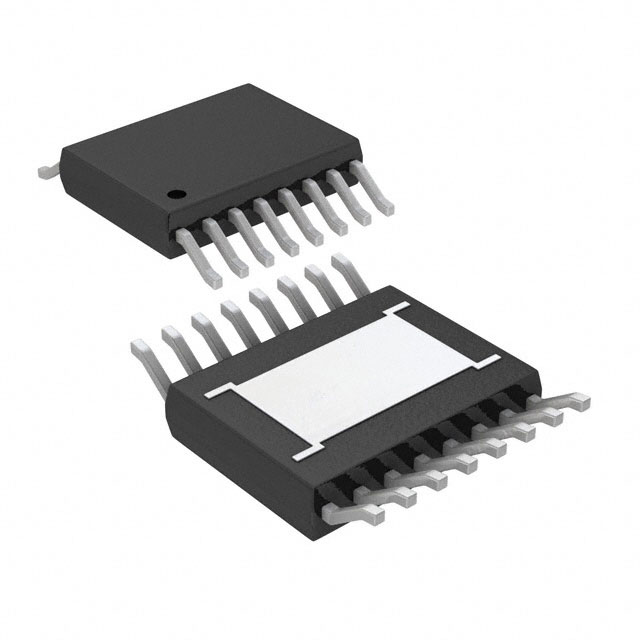Viz Specifikace pro podrobnosti o produktu.

LTC3775EMSE#PBF
Product Overview
Category
LTC3775EMSE#PBF belongs to the category of integrated circuits (ICs) specifically designed for power management applications.
Use
This product is commonly used in various power management systems, including but not limited to battery chargers, power supplies, and voltage regulators.
Characteristics
- High efficiency: LTC3775EMSE#PBF offers excellent power conversion efficiency, minimizing energy losses.
- Wide input voltage range: It can handle a wide range of input voltages, making it suitable for diverse applications.
- Multiple protection features: This IC incorporates various protection mechanisms such as overvoltage protection, overcurrent protection, and thermal shutdown, ensuring safe operation.
- Adjustable output voltage: The output voltage can be easily adjusted according to the specific requirements of the application.
Package
LTC3775EMSE#PBF is available in an MSOP-16 package, which provides compactness and ease of integration into different circuit designs.
Essence
The essence of LTC3775EMSE#PBF lies in its ability to efficiently manage power by regulating voltage levels, protecting against potential faults, and providing flexibility in adjusting output voltages.
Packaging/Quantity
This product is typically packaged in reels or tubes, with each reel/tube containing a specific quantity of LTC3775EMSE#PBF ICs. The exact quantity may vary depending on the supplier.
Specifications
- Input Voltage Range: 4V to 60V
- Output Voltage Range: 0.8V to 60V
- Maximum Output Current: 20A
- Switching Frequency: Up to 1MHz
- Operating Temperature Range: -40°C to 125°C
Detailed Pin Configuration
- VIN: Input voltage pin
- GND: Ground reference pin
- VOUT: Output voltage pin
- FB: Feedback pin for output voltage regulation
- EN: Enable pin to control the IC's operation
- SS: Soft-start pin for gradual power-up
- PGND: Power ground pin
- SW: Switching node pin for power transfer
Functional Features
- Wide input voltage range allows compatibility with various power sources.
- High efficiency conversion minimizes energy losses and maximizes power utilization.
- Adjustable output voltage enables customization according to specific application requirements.
- Multiple protection features ensure safe operation and protect against potential faults.
- Fast transient response ensures stability during load changes.
Advantages and Disadvantages
Advantages
- High efficiency leads to reduced power consumption and improved energy efficiency.
- Wide input voltage range provides versatility in different applications.
- Multiple protection mechanisms enhance system reliability and safety.
- Compact MSOP-16 package facilitates space-saving integration.
Disadvantages
- Limited maximum output current may not be suitable for high-power applications.
- Higher switching frequencies may introduce additional noise in sensitive circuits.
Working Principles
LTC3775EMSE#PBF operates based on a pulse-width modulation (PWM) control scheme. It regulates the output voltage by adjusting the duty cycle of the internal switches, which control the power flow from the input to the output. The feedback mechanism continuously monitors the output voltage and adjusts the duty cycle accordingly to maintain the desired voltage level.
Detailed Application Field Plans
LTC3775EMSE#PBF finds applications in various fields, including: 1. Battery chargers for portable devices such as smartphones, tablets, and laptops. 2. Power supplies for industrial equipment and automation systems. 3. Voltage regulators in automotive electronics and electric vehicles. 4. Solar power systems for efficient energy harvesting and storage. 5. LED lighting systems for optimal power management and control.
Detailed and Complete Alternative Models
- LTC3774EMSE#PBF: Similar to LTC3775EMSE#PBF with a higher maximum output current of 30A.
- LTC3776EMSE#PBF: Offers additional features such as adjustable switching frequency and synchronization capability.
- LTC3777EMSE#PBF: Suitable for applications requiring high input voltage range up to 100V.
These alternative models provide similar functionality to LTC3775EMSE#PBF but offer different specifications and features to cater to specific application requirements.
Word count: 540 words
Seznam 10 běžných otázek a odpovědí souvisejících s aplikací LTC3775EMSE#PBF v technických řešeních
Sure! Here are 10 common questions and answers related to the application of LTC3775EMSE#PBF in technical solutions:
Q: What is LTC3775EMSE#PBF? A: LTC3775EMSE#PBF is a high-performance synchronous step-down DC/DC controller IC manufactured by Linear Technology (now part of Analog Devices). It is designed for use in various power supply applications.
Q: What is the input voltage range supported by LTC3775EMSE#PBF? A: LTC3775EMSE#PBF supports an input voltage range from 4.5V to 38V, making it suitable for a wide range of power supply designs.
Q: What is the output voltage range that can be achieved with LTC3775EMSE#PBF? A: The output voltage range of LTC3775EMSE#PBF depends on the external components used in the design. It can support output voltages as low as 0.6V and as high as the input voltage.
Q: What is the maximum output current that LTC3775EMSE#PBF can handle? A: LTC3775EMSE#PBF can handle a maximum output current of up to 20A, making it suitable for applications requiring high power delivery.
Q: Does LTC3775EMSE#PBF have any built-in protection features? A: Yes, LTC3775EMSE#PBF includes various protection features such as overvoltage protection, overcurrent protection, and thermal shutdown to ensure safe operation of the power supply.
Q: Can LTC3775EMSE#PBF be used in both buck and boost converter configurations? A: No, LTC3775EMSE#PBF is specifically designed for synchronous step-down (buck) converter applications. It is not suitable for boost converter configurations.
Q: What is the switching frequency range of LTC3775EMSE#PBF? A: The switching frequency of LTC3775EMSE#PBF can be programmed from 100kHz to 1MHz, allowing flexibility in optimizing efficiency and component size.
Q: Does LTC3775EMSE#PBF support external synchronization? A: Yes, LTC3775EMSE#PBF supports external synchronization, which allows multiple converters to operate in phase or at different frequencies.
Q: Can LTC3775EMSE#PBF operate in a wide temperature range? A: Yes, LTC3775EMSE#PBF is specified to operate over a temperature range of -40°C to 125°C, making it suitable for various industrial and automotive applications.
Q: Are there any evaluation boards or reference designs available for LTC3775EMSE#PBF? A: Yes, Analog Devices provides evaluation boards and reference designs for LTC3775EMSE#PBF, which can help users quickly prototype and develop their power supply solutions.
Please note that the answers provided here are general and may vary depending on specific application requirements. It is always recommended to refer to the datasheet and application notes provided by the manufacturer for detailed information.

